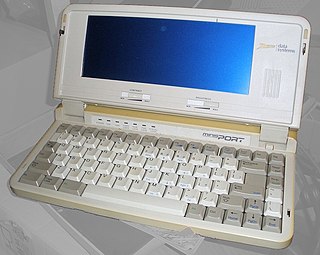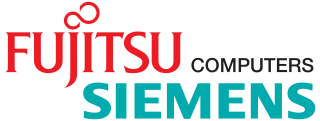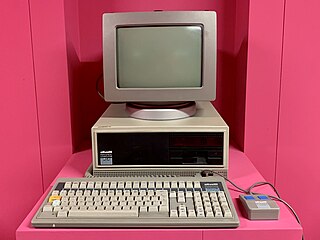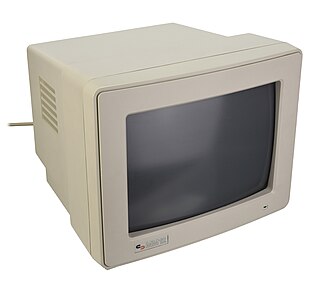
The Intel 80186, also known as the iAPX 186, or just 186, is a microprocessor and microcontroller introduced in 1982. It was based on the Intel 8086 and, like it, had a 16-bit external data bus multiplexed with a 20-bit address bus. The 80188 variant, with an 8-bit external data bus was also available.
Amstrad was a British electronics company, founded in 1968 by Alan Sugar at the age of 21. The name is a contraction of Alan Michael Sugar Trading. It was first listed on the London Stock Exchange in April 1980. During the late 1980s, Amstrad had a substantial share of the PC market in the UK. Amstrad was once a FTSE 100 Index constituent, but since 2007 has been wholly owned by Sky UK. As of 2006, Amstrad's main business was manufacturing Sky UK interactive boxes. In 2010, Sky integrated Amstrad's satellite division as part of Sky so they could make their own set-top boxes in-house.

The Tandy 1000 is the first in a line of IBM PC compatible home computer systems produced by the Tandy Corporation for sale in its Radio Shack and Radio Shack Computer Center chains of stores. Introduced in 1984, the product line was aimed at providing affordable but capable systems for home computing or education, with some of its Tandy specific features like graphics, sound and joystick port making it more appealing for home use.

The Personal System/2 or PS/2 is IBM's second generation of personal computers. Released in 1987, it officially replaced the IBM PC, XT, AT, and PC Convertible in IBM's lineup. Many of the PS/2's innovations, such as the 16550 UART, 1440 KB 3.5-inch floppy disk format, 72-pin SIMMs, the PS/2 port, and the VGA video standard, went on to become standards in the broader PC market.

The Tandy 2000 is a personal computer introduced by Radio Shack in September 1983 based on the 8 MHz Intel 80186 microprocessor running MS-DOS. By comparison, the IBM PC XT used the older 4.77 MHz Intel 8088 processor, and the IBM PC/AT would later use the newer 6 MHz Intel 80286. Due to the 16-bit data bus and more efficient instruction decoding of the 80186, the Tandy 2000 ran significantly faster than other PC compatibles, and slightly faster than the PC AT. The Tandy 2000 was the company's first computer built around an Intel x86 series microprocessor; previous models used the Zilog Z80 and Motorola 6809 CPUs.

The FM Towns is a Japanese personal computer built by Fujitsu from February 1989 to the summer of 1997. It started as a proprietary PC variant intended for multimedia applications and PC games, but later became more compatible with IBM PC compatibles. In 1993, the FM Towns Marty was released, a game console compatible with existing FM Towns games.

The Zenith MinisPort is a subnotebook based on an 80C88 CMOS CPU running at two software selectable speeds: 4.77 MHz or 8 MHz. It was released in 1989 by Zenith Data Systems (ZDS).

Fujitsu Siemens Computers GmbH was a Japanese and German vendor of information technology. The company was founded in 1999 as a 50/50 joint venture between Fujitsu Limited of Japan and Siemens of Germany. On April 1, 2009, the company became Fujitsu Technology Solutions as a result of Fujitsu buying out Siemens' share of the company.
The Acorn Business Computer (ABC) was a series of microcomputers announced at the end of 1983 by the British company Acorn Computers. The series of eight computers was aimed at the business, research and further education markets. Demonstrated at the Personal Computer World Show in September 1984, having been under development for "about a year" and having been undergoing field trials from May 1984, the range "understandably attracted a great deal of attention" and was favourably received by some commentators. The official launch of the range was scheduled for January 1985.

The Sun386i is a discontinued hybrid UNIX workstation/PC compatible computer system produced by Sun Microsystems, launched in 1988. It is based on the Intel 80386 microprocessor but shares many features with the contemporary Sun-3 series systems.
The Mac286 was an Intel 80286-based MS-DOS coprocessor expansion card for one of Apple Computer's first expandable Macintosh computers, the 1987 Macintosh II. It was developed by Phoenix Technologies under contract to Apple Computer and sold by AST Research in an effort to close the gap between the Macintosh and IBM PC computing worlds. AST also introduced the related Mac86 card for the Macintosh SE.
VAXmate was an IBM PC/AT compatible personal computer introduced by Digital Equipment Corporation in September, 1986. The replacement to the Rainbow 100, in its standard form it was the first commercial diskless personal computer.
The Fujitsu Micro 16s was a business personal computer from Fujitsu that was launched in 1983, around the same time as the launch of the original IBM PC/XT. The Micro 16s used a plug in microprocessor board, and two models were offered, an Intel 8086 and a Zilog Z80 expansion board. Additional expansion boards with the Motorola 68000, Intel 80286 and Zilog Z8000 processors were also planned. Additionally it had a Motorola 6809 co-processor.

The Olivetti M24 is a computer that was sold by Olivetti in 1983 using the Intel 8086 CPU.
The ICL DRS was a range of departmental computers from International Computers Limited (ICL). Standing originally for Distributed Resource System, the full name was later dropped in favour of the abbreviation.

Lira 512 was an IBM PC XT compatible computer made by the Yugoslav company EI Niš in the late 1980s. It was first presented to the public in April 1988 at the “Kompjuter ‘88” computer show in Belgrade. Soon after that, Lira 512 was also presented in Yugoslav computer press.
The Tandy 3000 is a personal computer introduced by Radio Shack in 1986 based on the 16-bit 8 MHz Intel 80286 microprocessor.
Toshiba Pasopia 16 or PA7020 is an IBM PC compatible computer from manufacturer Toshiba, released in 1982 and based around a Intel 8088-2 microprocessor running at 6 MHz.

The Schneider Euro PC was a PC compatible home computer, introduced in 1988 by the Schneider Computer Division.
Léanord was a French computer brand, founded in 1960 at Haubourdin, near Lille. It was a subsidiary of Creusot-Loire and started to develop computers in the late 1970s.











